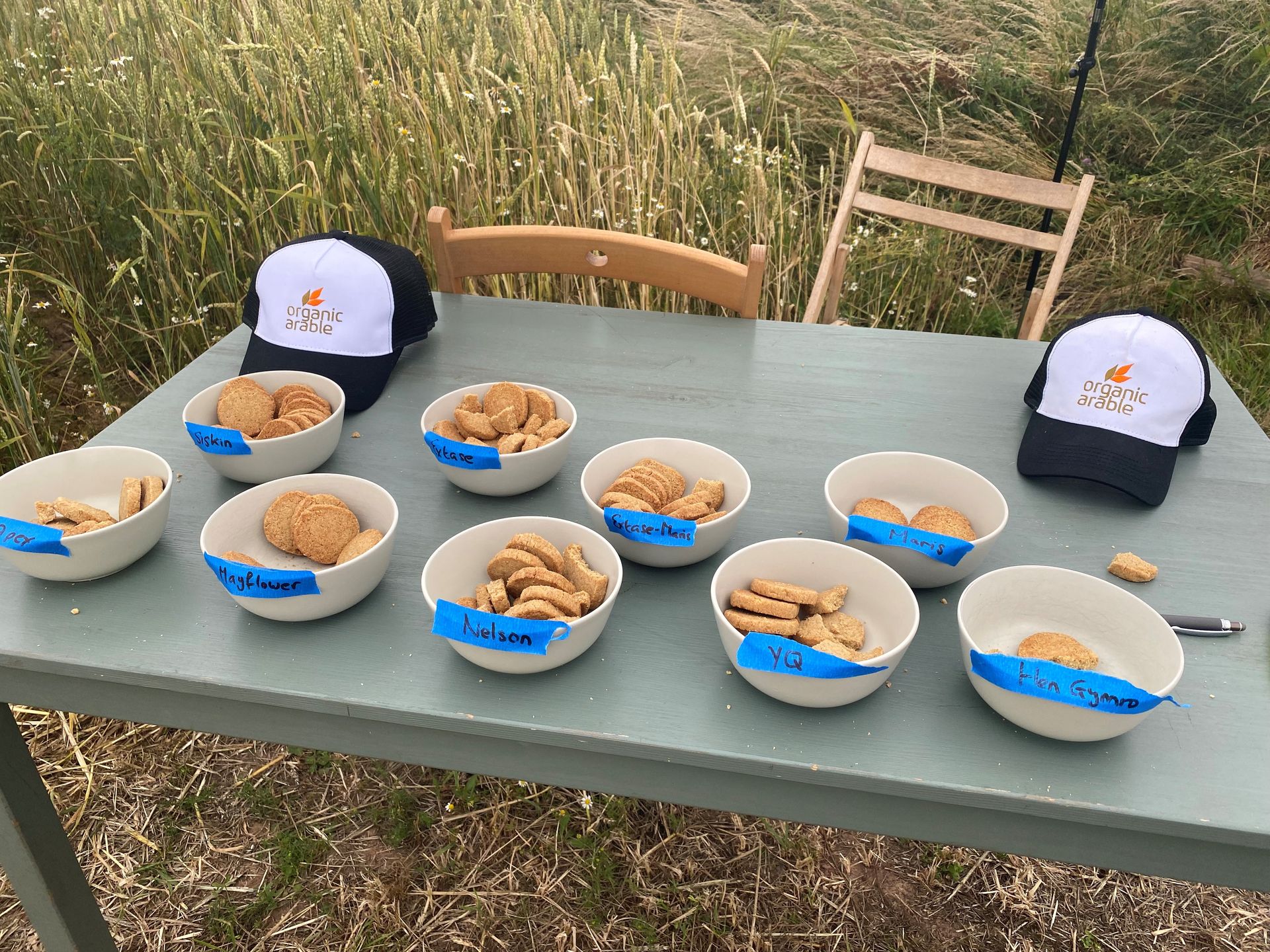Firstly, many thanks to Mark Lea of Green Acres Farm for hosting an excellent event. As well as the stand and the usual moisture meter clinic, Organic Arable had a good presence on the farm walk, presenting at both the wheat and oat stations.
Wheat Station
As part of the farm walks in the afternoon Dom discussed the LiveWheat Legacy trials and Mark's heritage wheats. The wheat trials looked excellent with some interesting differences in traits amongst the varieties on display. The field station talks began looking at the old cultivar Maris Widgeon, that had been bred in the 1950s by the PBI and is still commercially available from Pearce Seeds. The variety is talled strawed and weed suppressive as well as showing the trait of grain protein deviation, meaning it has higher protein than expected from it's yield compared to other varieties. It is prized by some millers and bakers and works well on Mark's Farm when he mills and sells direct to market. One drawback on more fertile ground can be a higher risk of lodging, and with the stormy weather in mid-June, the variety had indeed lodged in places. The next strip we looked at was a blend of MAris Widgeon and Extase, taking the best of old and modern cultivars to maximise complementarity of traits in height, rooting depth, vigour, disease resistance and growth cycle, hopefully reducing the competiton for resources within the blend. Another benefit of combining the two was that the Widgeon hadn't lodged. Moving through the varieties we then looked at Extase on its own, a blend with Nelson and Nelson on its own. Extase is now renowned as a reliable, variety that offers weed suppression and good yields. Mixed with Nelson, a high quality milling wheat, it is hoped it will improve over all quality whilst maintaining yield. The next variety that was discussed was Mayflower, new to the recommended list this year and showing the exceptional trait of weed suppression, due to its early prostrate growth habit. In fact it may be one of the stand out findings from this and previous year's trials having found a variety with such an outstanding and important trait for organic farming. Of course its weed suppressive trait isn't a guarantee of high yield but if it does turn out to be lower yielding it may be a good candidate for blending with a higher yielding variety. The difference in weed suppression between Mayflower and Siskin was very visible in the trials and this has been a pattern repeated across the sites where Mayflower has been included. It has suppressed charlock, mayweed, poppies and even wild oats across different farms. Finally we discussed the ORC Wakelyns population, a composite cross of several varieties that is genetically diverse and can now be marketed legally thanks to a new Statutory Instrument in force for the next seven years. YQ has a cult following amongst small scale bakers and again works well at Mark's where the farm is geared towards direct marketing of heritage and population wheats.
As a nice accompaniment to the wheat strips we had biscuits made from all the different varieties on trial for people to taste at the station.
Oat Station
5 varieties were included in the trial at Greenacres with Isabel the control. Alongside it were Vaughan, Zenith, Timpani and Merlin and in addition there was strip treated with Tiros seed treatment.
Reasons for selection of new varieties
Vaughan
Breeder: RAGT
New entrant to RL. Highest kernel content after Isabel, good straw length and good disease resistance.
Zenith
Breeder: Senova
Candidate variety on RL. Same Kernel Content as Isabel, slightly shorter with good crown rust resistanceTimpani
Breeder: IBERS
It is a variety IBERS felt would suit organic systems. It is still in their breeding programme and had not yet started RL testing.zZ
Zenith grain quality compared to Merlin and Isabel
Observations on the day
All the strips looked fantastic! There was some mildew present in all varieties except Timpani which remained the most green and seemingly slightly later developing. None of the mildew was at a troubling level although highest in the Merlin.
None of the varieties had noticeable levels of tertiary grains in the spikelets but the Zenith grain size seemed to be larger than the other varieties and it will be interesting to see if this is the case in the harvested grain.





